Perfectly Roasted Cabbage with Blue Cheese Sauce is one of the easiest and most delicious ways to enjoy the often-ignored green cabbage. Turn this ordinary side dish into extraordinary with a velvety rich drizzle of blue cheese sauce.
Cabbage is one of the most versatile vegetables you can find in any grocery store. Here at NWTN, you’ll find many great recipes, including these classic Cabbage Rolls, Creamed Cabbage and our Corned Beef and Cabbage – Slow Cooker or this super easy Haluski recipe, which is great for quick weeknight meals. Or even try its cousin Air Fryer Brussels Sprouts, so good!!
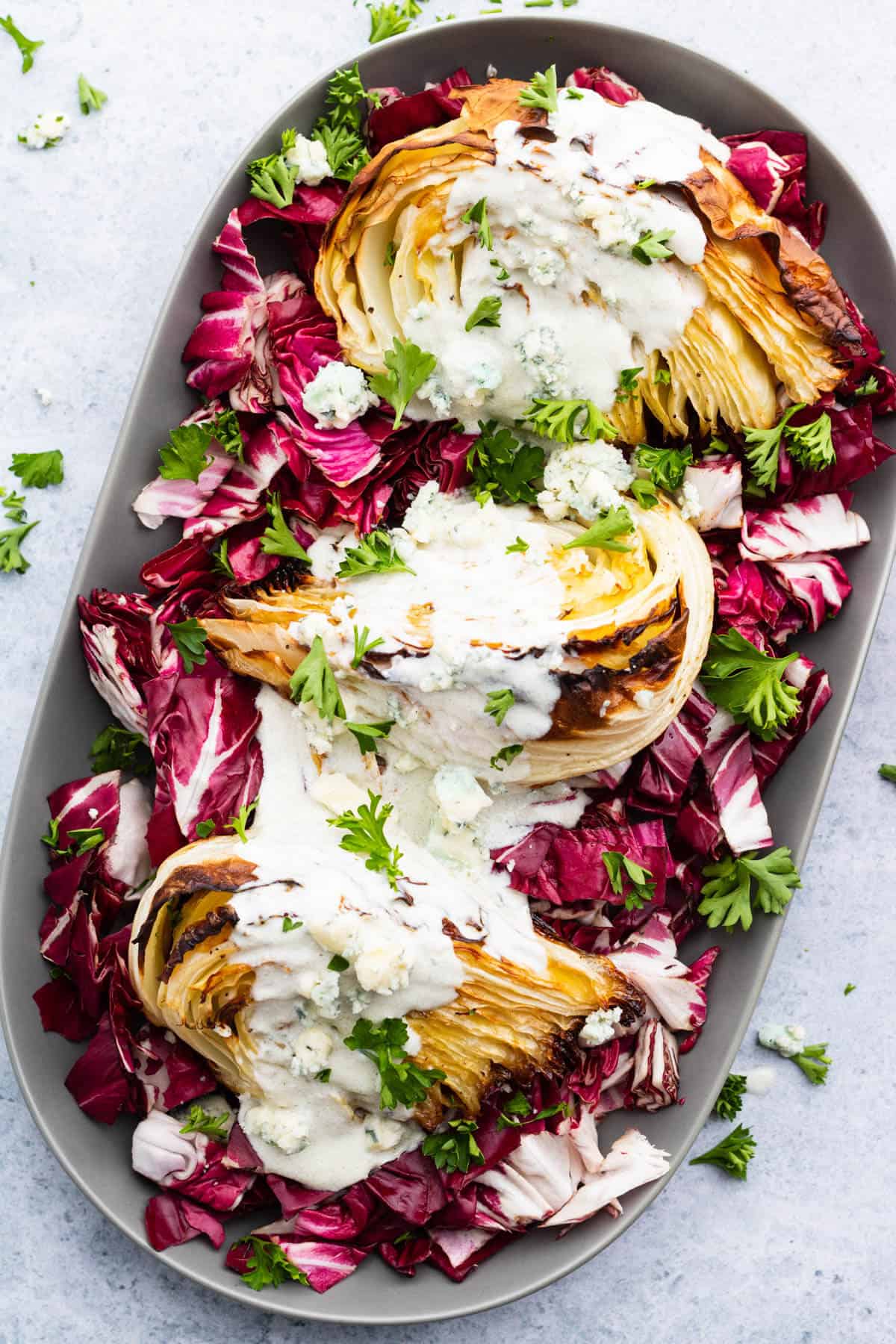
Helpful Items For This Recipe
This post contains affiliate links. As an Amazon Associate, I earn a small portion from qualifying purchases at no extra charge for you.
Roasted Cabbage with Blue Cheese Sauce
Oven roasting is one of the easiest ways to transform an ordinary raw vegetable, such as cabbage, into a rock star.
The high temperature transforms the cruciferous vegetable at the most basic level and amplifies the flavours hidden within cell walls.
Flavour wise, the inner leaves of the roasted cabbage achieve a surprising sweetness, complimented by the slight bitterness of an over caramelized crispy edge.
Left in wedges, the ordinarily tough cabbage layers soften as they roast, while the outer layers and edges fall prey to the high heat. Best of all, it’s the blackened bits that steal the show.
Serving the perfectly roasted cabbage wedges on their own is quite delicious. However a generous pour of (3 ingredient!) creamy blue cheese sauce brings the dish to restaurant level.
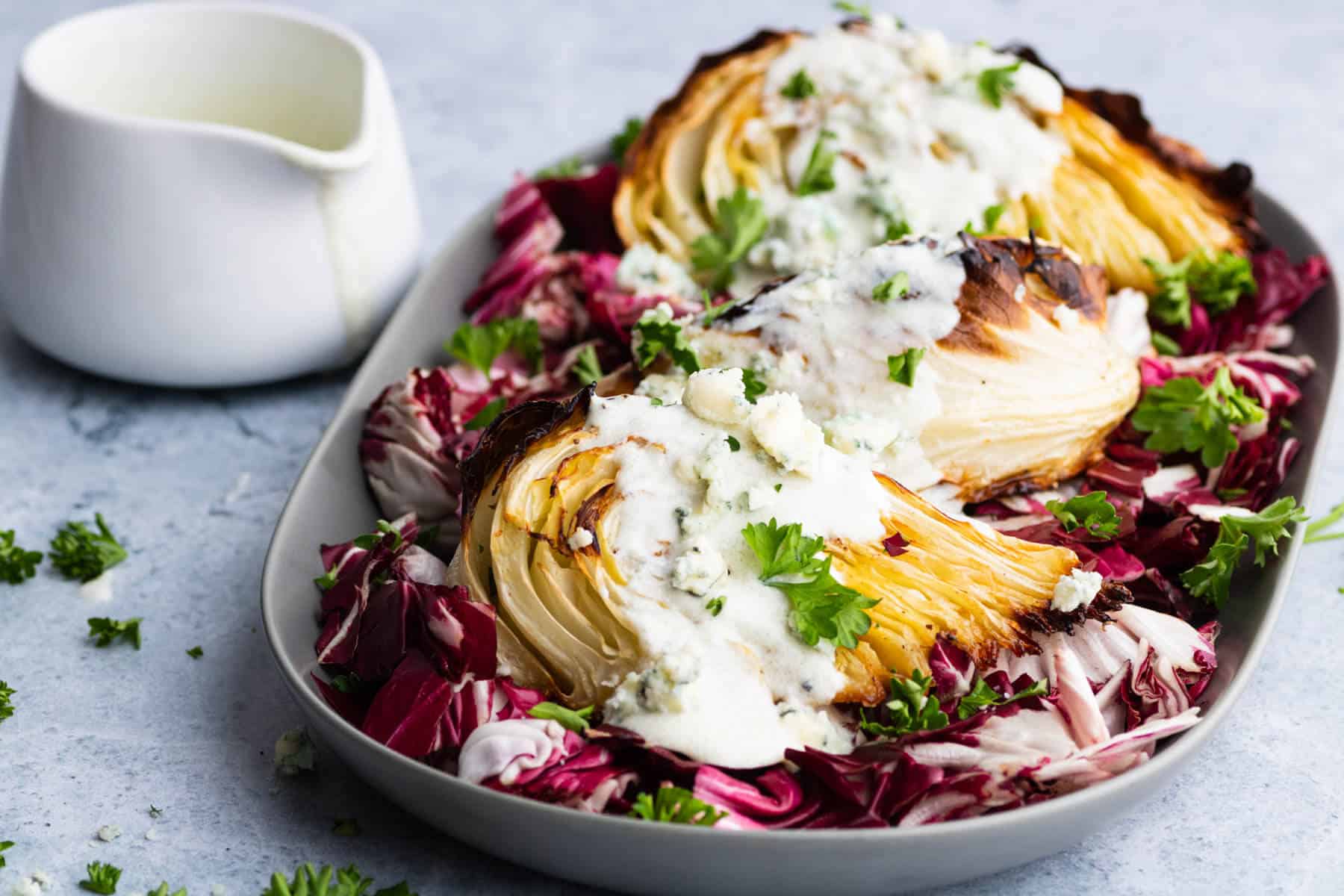
Hello again! It’s Bernice from dishnthekitchen and I am thrilled to finally be sharing this recipe for Tara. We enjoyed a similar cabbage dish together a few years ago and we’ve been dreaming about it ever since!
As it turns out, we are both obsessed with cabbage and the vast array of dishes we can make with this simple vegetable. I love Red Cabbage braised the traditional German way and insist on fermenting my own Sauerkraut, using the same method Grandma taught me.
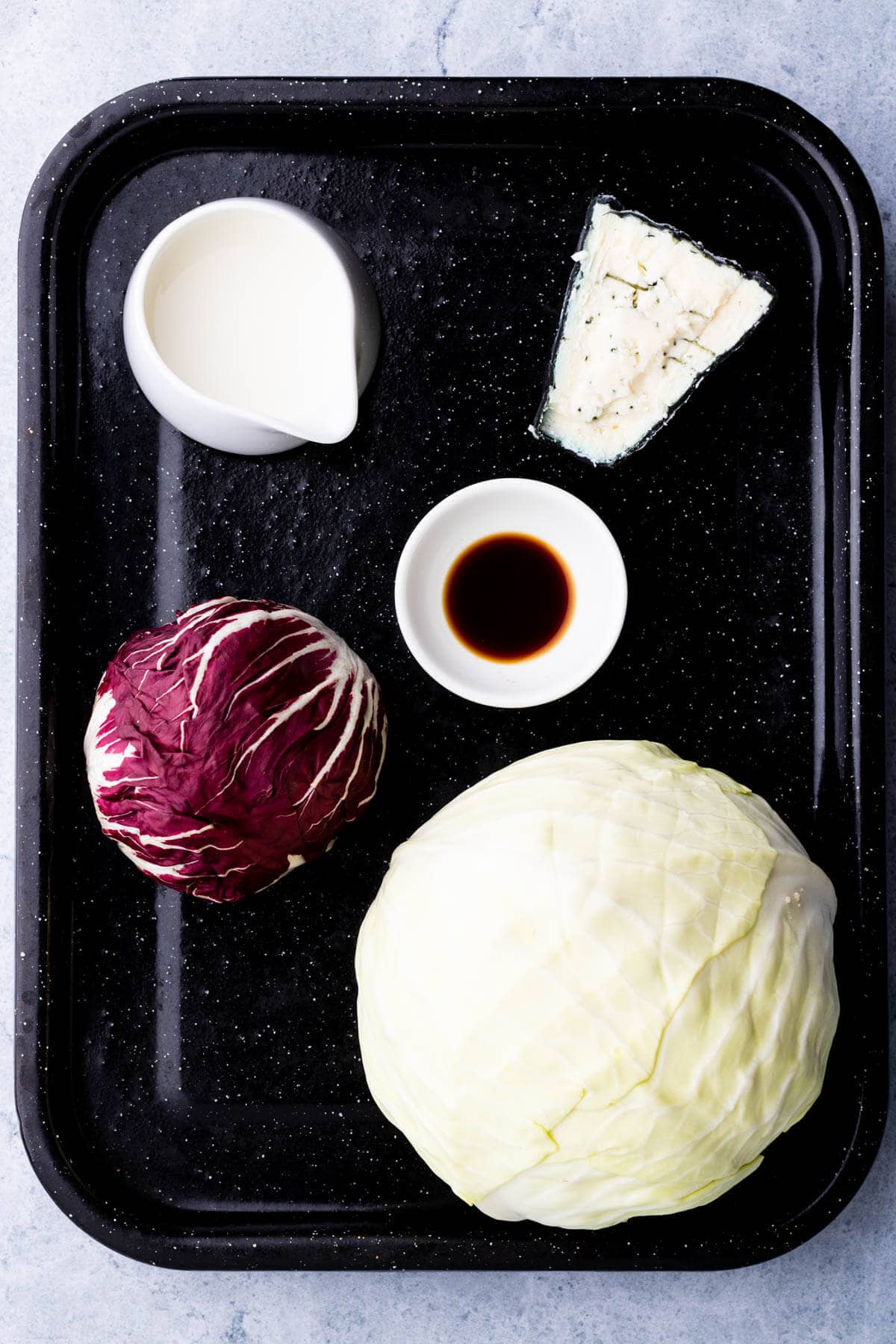
A Few Words About Cabbage
Cabbage is only one member of a large family of vegetables called Brassicae or more often Cruciferae (singular form cruciferous). Other members of the family include cauliflower, Brussels Sprouts, Broccoli, Turnips, Radishes, Kohlrabi; just to name a few.
Besides being inexpensive, long-lasting, readily available, and versatile; a head of cabbage is very healthy. So, healthy that it could be considered a ‘superfood’.
This nutritional powerhouse is low in calories but high in fibre and water content which is great news for your digestive system and cholesterol levels. Want even more great news?
Cabbage is an excellent source of vitamins K, C, B6, and folate as well as important minerals like magnesium, calcium, iron, and potassium. It’s also full of antioxidant compounds that may help prevent certain cancers. READ MORE.
Cabbage, at its core, is quite basic but it sure isn’t boring! Think of it more as a ‘blank canvas’ for all the wonderful flavours and textures of the culinary world.
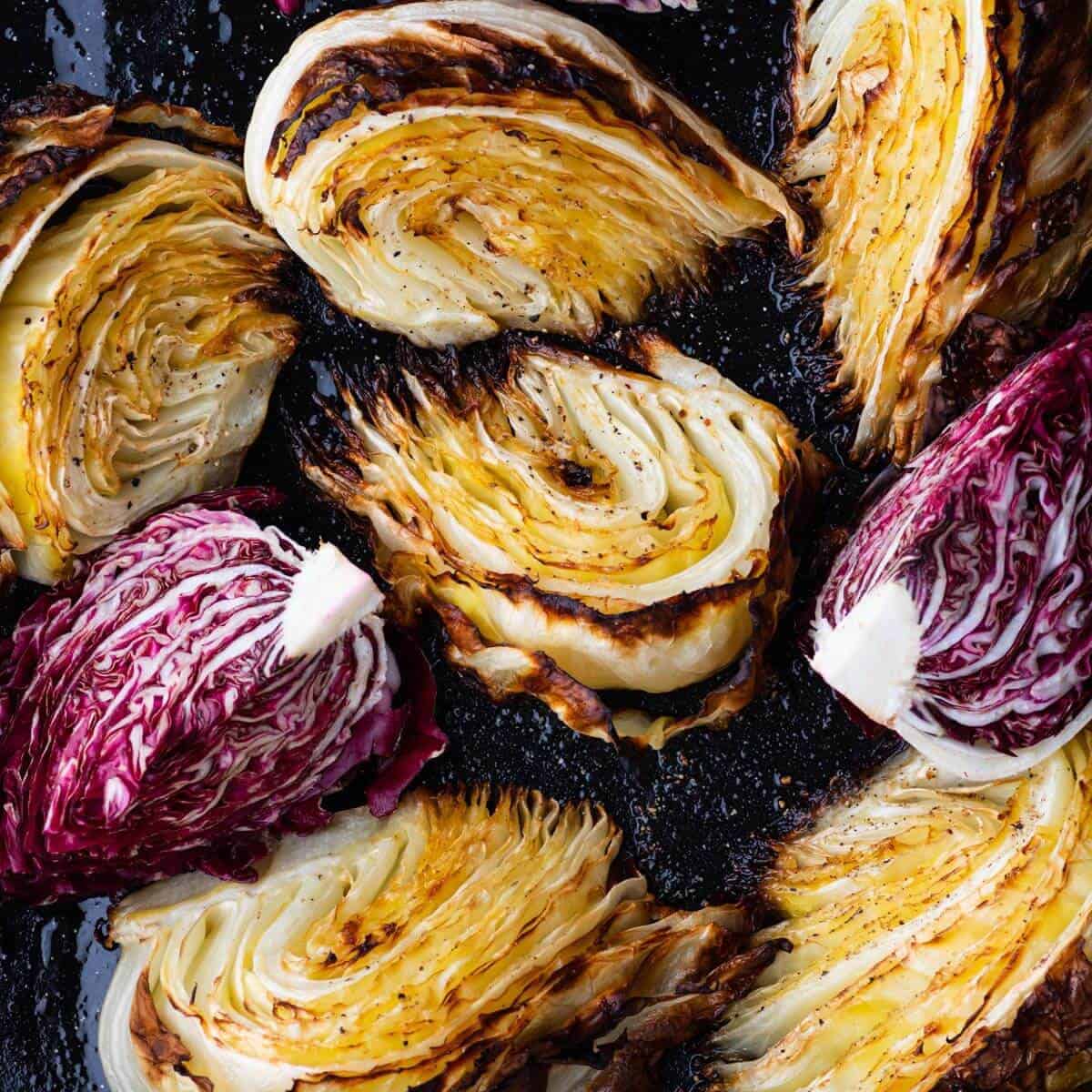
Is Radicchio the Same as Cabbage?
In the photos, you may have noticed the base of brightly coloured leafy vegetables lining the platter of roasted cabbage. This is not Red Cabbage, it’s Chioggia Radicchio.
At first glance, this radicchio is very similar to red cabbage. It’s a relatively compact sphere with concentric leafy layers. The two even have similar health benefits.
Botanically, radicchio is not considered a Brassica and belongs to an entirely different family. It does not deliver the same flavours that roasted cabbage does and is much more delicious raw. It has a nutty flavour and characteristic bitterness.
Dress it with a simple vinaigrette or give it a quick pickle treatment before serving.
Which Cabbage is Good for Roasting?
There are so many different varieties of cabbage; it’s a vegetable that is astonishingly varied in colour, size, and texture. Feel free to experiment with any of the following varieties using the roasting technique.
There’s the gorgeous Red Cabbage and Purple/Green January King Cabbage to the gorgeous ombré hues of frilly Savoy and bright Napa Cabbage. Who can leave out the sweet little ‘baby’ cabbages aka Brussels Sprouts?
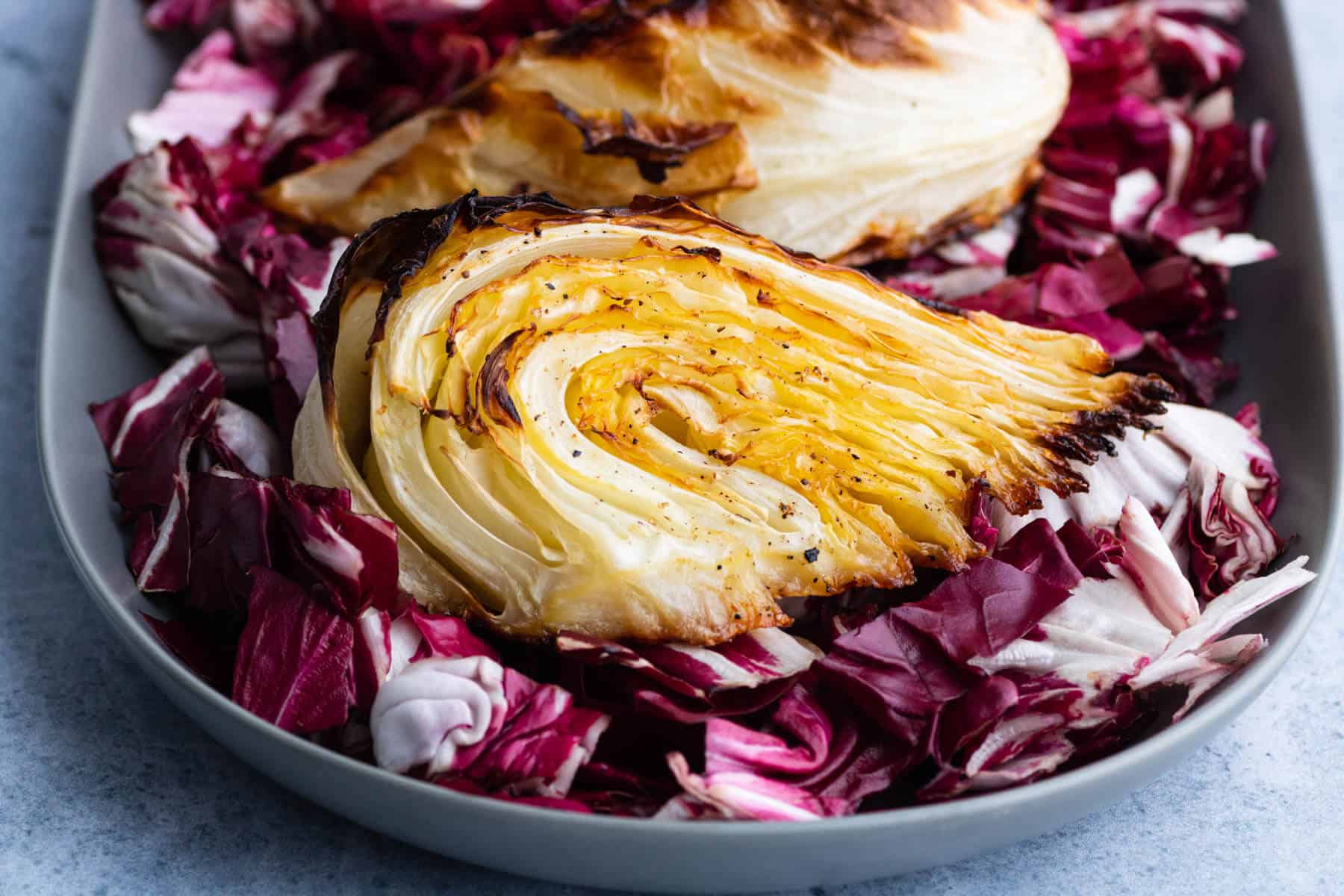
This recipe features the common green cabbage or ‘cannonball’ cabbage because it is the one that is available at most grocery stores.
How to Cut the Cabbage into Wedges
If the health benefits haven’t convinced you to eat cabbage, the simplicity of this recipe will. It really is as easy as chop, drizzle, season, and roast.
Take care while preparing the cabbage because it can be a bit awkward at first. A sharp knife and a stable cutting board make this job easier and safer.
To divide the cabbage into eight equal wedges, begin by slicing it into half though the stem end. Next, remove part of the core by carving out an upside down ‘v’. Keep a small amount of the core in as it binds the wedges together.
Continue preparing the cabbage by slicing through each half though the core again, then repeat one more time to finish with 8 wedges.
NOTE: It’s not necessary to cut the cabbage into wedges. This dish will turn out just as tasty with randomly sliced cabbage chunks.
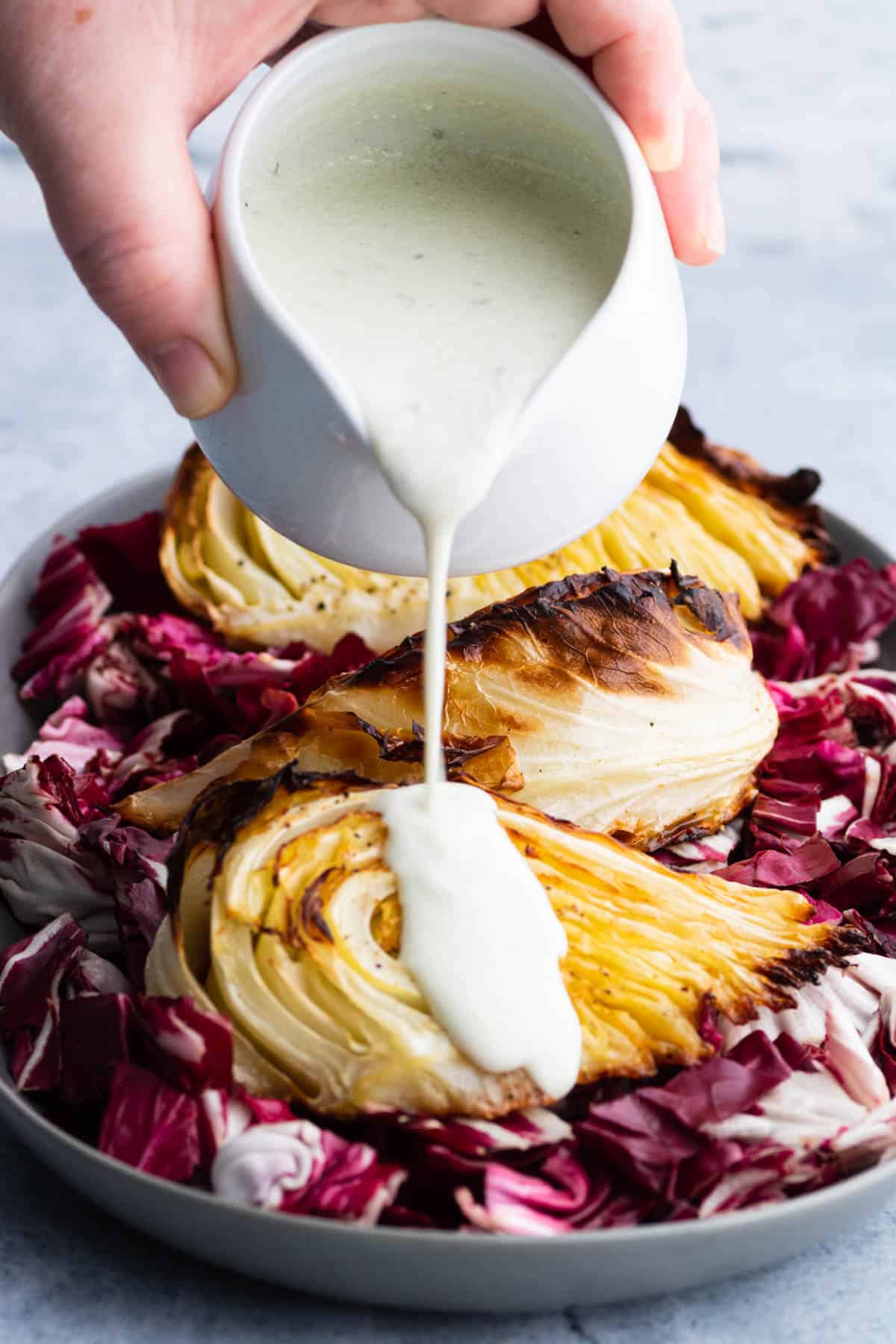
How to Roast Cabbage
The cabbage’s wonderful frilly charred bits can only occur during roasting at high temperatures. Preheat the oven to 400F.
Prepare a dark roasting pan with a generous drizzle of olive oil then arrange the cabbage wedges in a single layer. Brush or drizzle more olive oil over the wedges then season them generously with kosher salt and pepper.
Roast the cabbage for at least 45 minutes. This will ensure that the inner layers are thoroughly cooked. The longer the cabbage roasts, the darker and crispier the outer layers will be.
Feel free to adjust the time up to an hour (or more) depending on how dark you prefer the end result to be.
How to Make Blue Cheese Sauce
If you thought roasting the cabbage was easy, then this sauce will blow you away! It consists of only three ingredients and still packs a huge flavour profile.
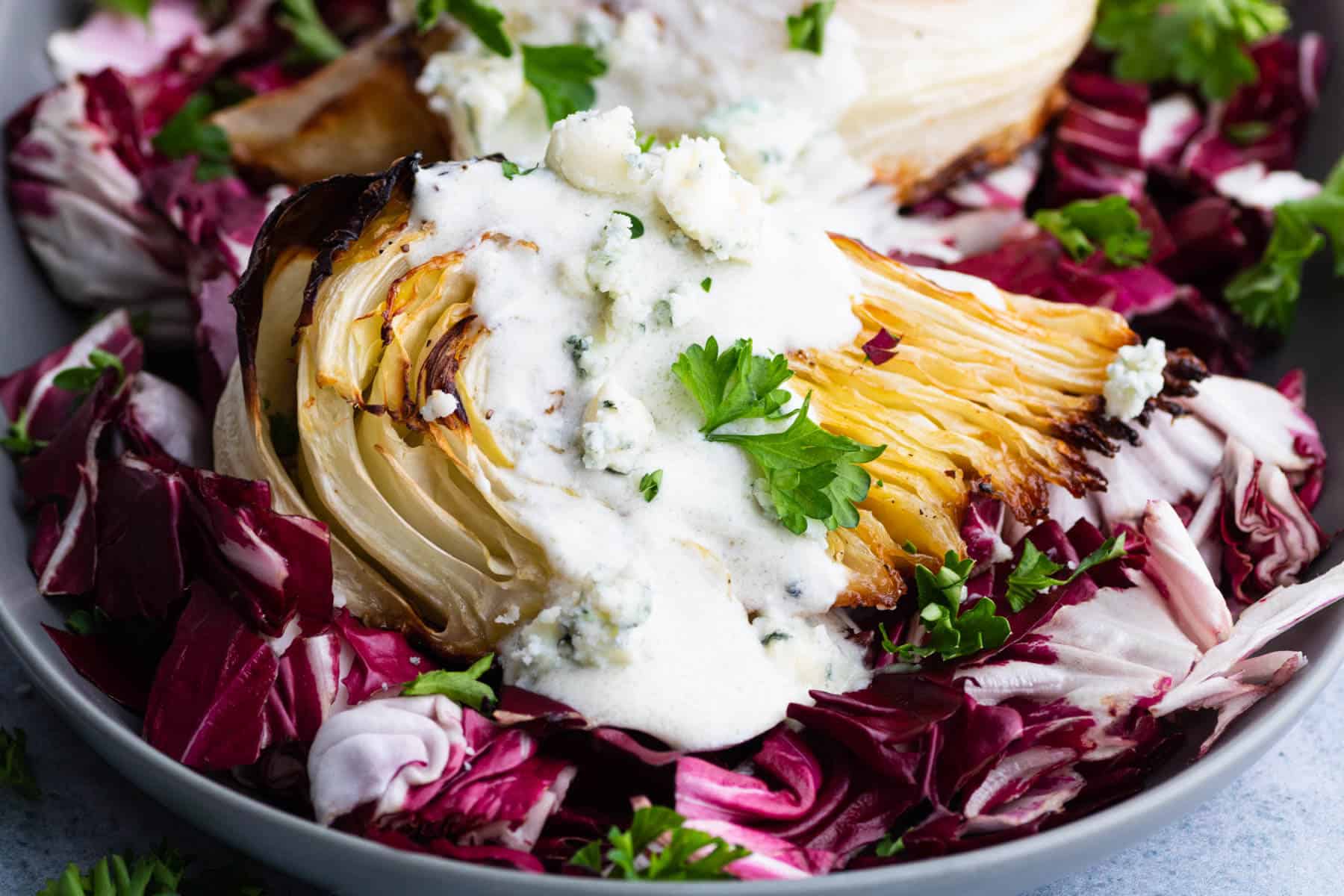
Place the blue cheese, heavy cream, and Worcestershire Sauce in a small saucepan. Warm them together over low heat, whisking continuously.
Once the sauce has come together, it becomes a thickened sauce on its own. There’s no need to add a flour slurry or other thickening agent. Season with salt and pepper to finish.
How to Serve Roasted Cabbage
Perfectly roasted cabbage is a wonderful dish on its own. Covering it in blue cheese sauce elevates the dish with relatively little extra effort.
To serve, scatter the radicchio leaves (if using) on the platter and arrange the roasted cabbage wedges over top. Pour the warm creamy blue cheese sauce over it all and garnish with extra bits of blue cheese and fresh parsley. Serve immediately.
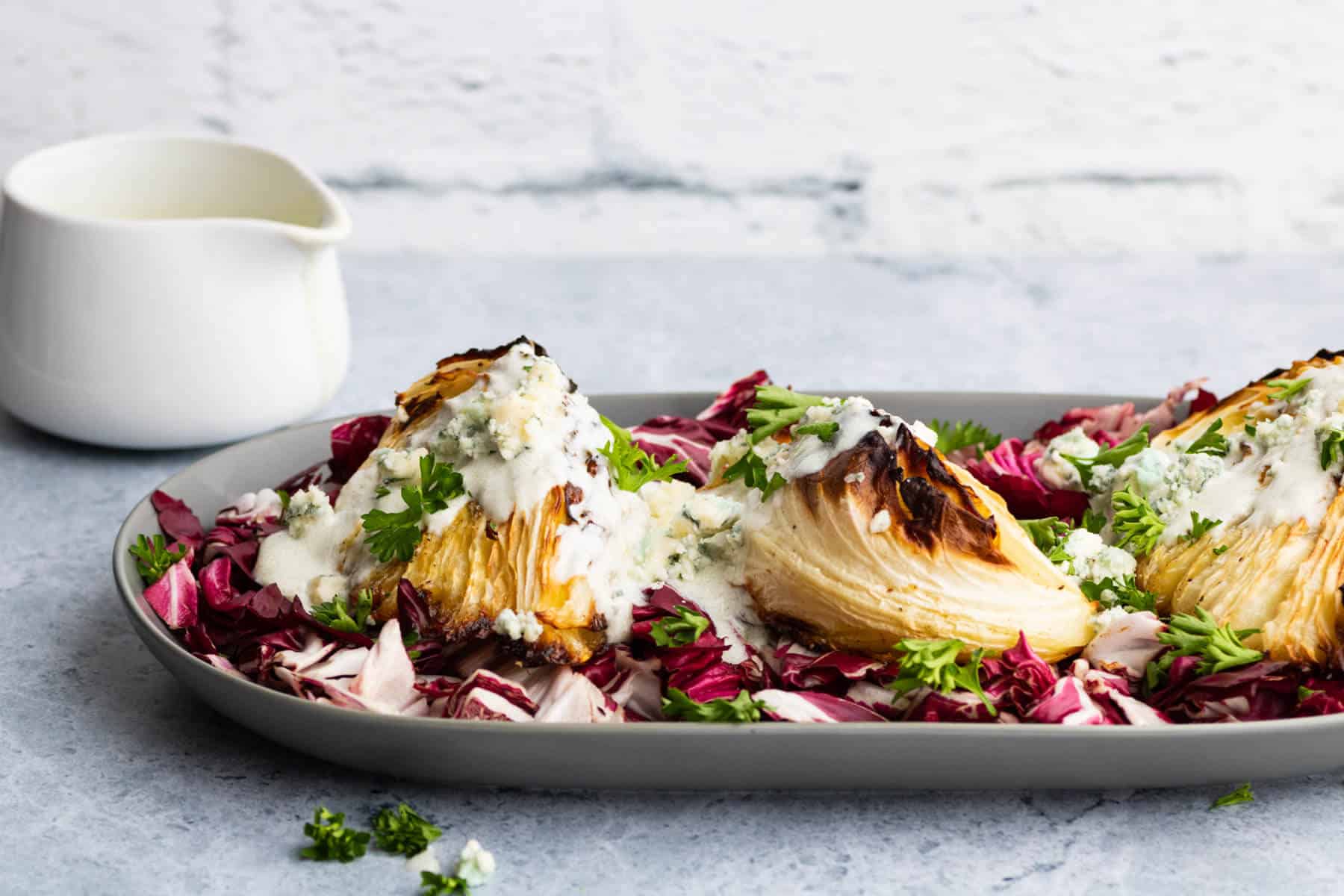
Storing and Reheating Roasted Cabbage
Roasted cabbage will store very well in an enclosed container in the fridge for up to a week. Store the full dish (including sauce) similarly and consume within 3 days.
To reheat this dish place it on a rimmed baking sheet and reheat in a 350F oven for 15 minutes. Alternatively, cook cabbage in a sauté pan and heat gently via stove top, or simply use the microwave.
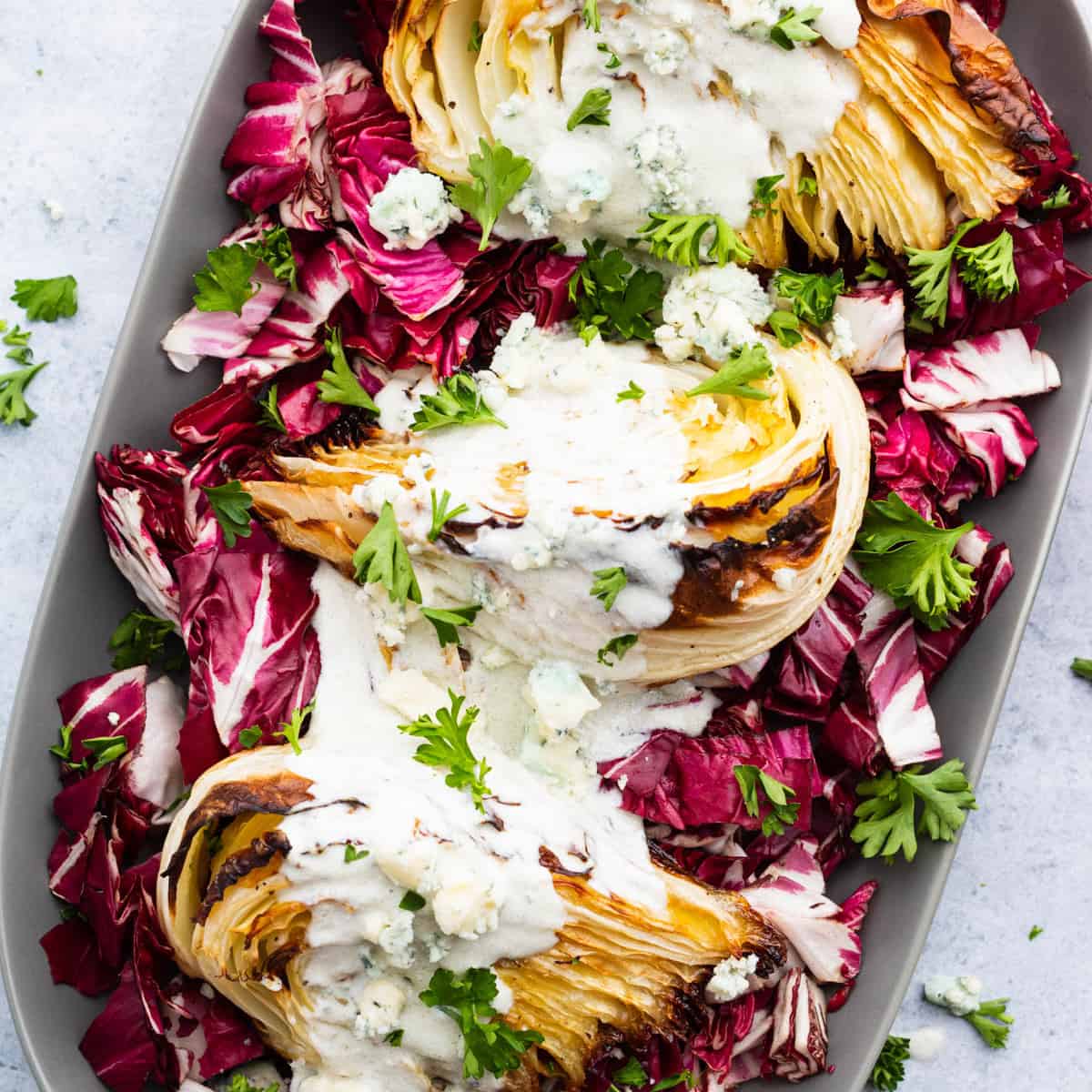
Pin it HERE!!
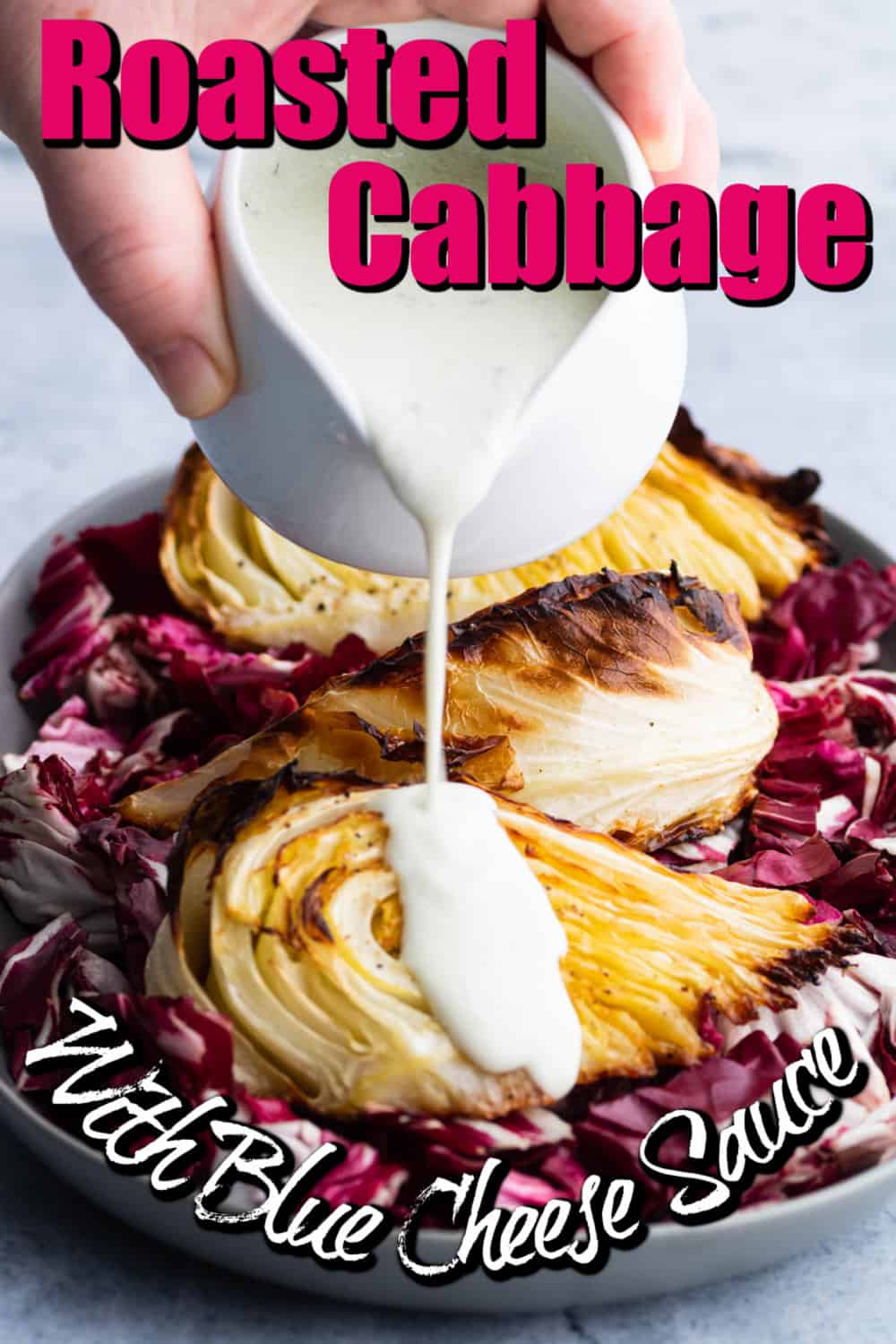
Pin it HERE!!

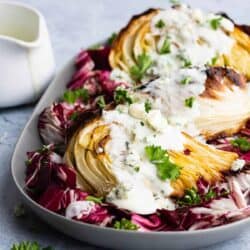
Roasted Cabbage with Blue Cheese Sauce
Ingredients
- 1 medium head green cabbage
- olive oil
- salt and pepper
- 1 cup heavy cream
- 1 1/4 cup blue cheese; crumbled and divided
- 1 tbsp Worcestershire Sauce
- salt and pepper
- 1 head Chioggia Radicchio optional
- 2 tbsp fresh parsley optional
Instructions
- Preheat oven to 400 F.
- Slice the cabbage through the middle of the core and continue all the way through.
- Remove the bottom half of the core from each piece.
- Cut each half into half again through the core area, and repeat again. In the end there will be 8 wedges.
- Drizzle olive oil all over the bottom of a roasting pan.
- Place each wedge flat side down in the oil, rub then flip over again.
- Roast for 45 minutes, or more depending on how crispy you want the cabbage to be.
- While the cabbage is roasting, place the cream, Worcestershire and blue cheese together in a small saucepan.
- Heat them together on medium low heat, whisking as it warms up.
- Once the blue cheese has incorporated into the milk, allow to come to a slight simmer then immediately remove from the heat.




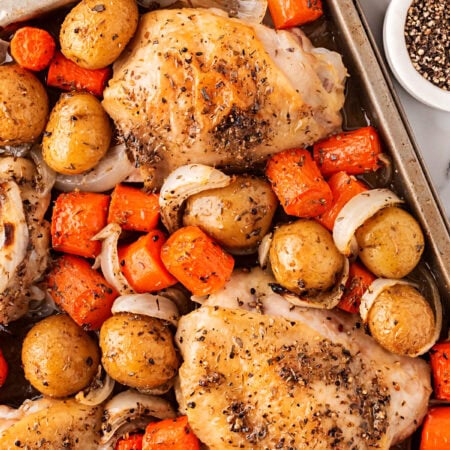

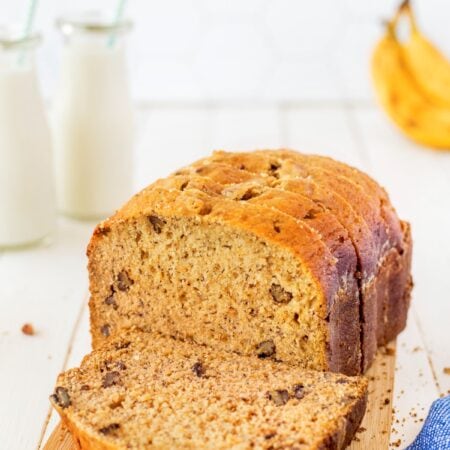
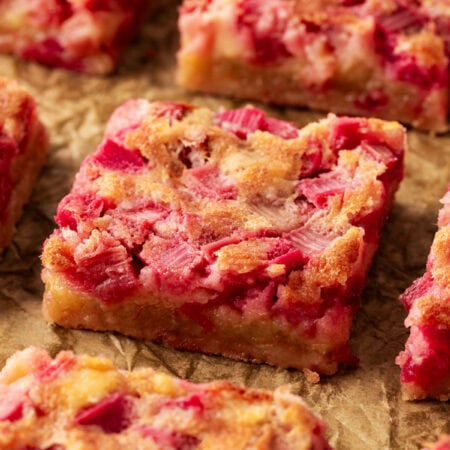

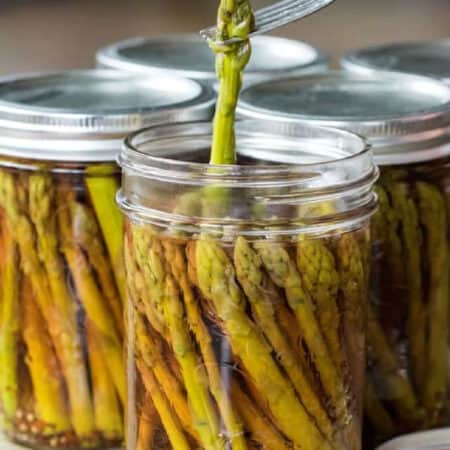

Let us know what you think!
We’d love to know what you and your family think! Make sure to leave a review below and follow us on your favorite social network!